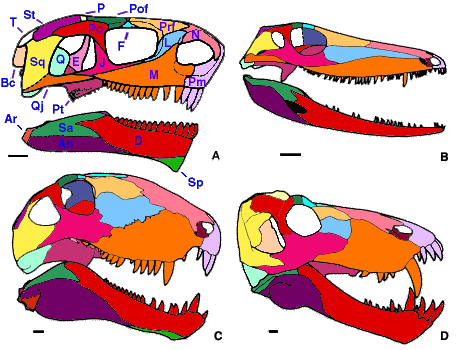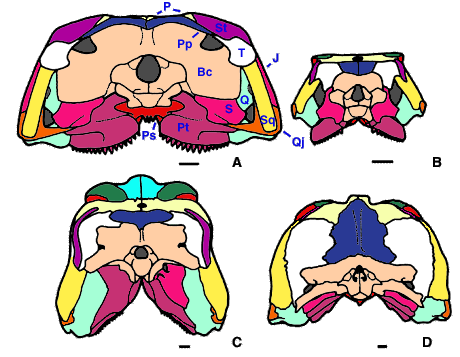The classification of synapsids may be summarized as follows:
=============================================================== Eothyrididae
==Caseasauria=|
| =============================================================== Caseidae
|
| ============================================================ Varanopseidae
| |
| | ======================================================== Ophiacodontidae
| | |
| | | ==================================================== Edaphosauridae
| | | |
=====| | | | =================================== Haptodus garnettensis
| | | | |
==Eupelycosauria=| | | | =============================== Palaeohatteria
==A=| | | |
==B=| | | =========================== Pantelosaurus
==Sphenacodontia=| | |
==C=| | ======================= Cutleria
==D=| |
==E=| === Sphenacodontidae
==Sphenacodontoidea=|
=== Therapsida
This classification and the list of apomorphies given below is taken from recent studies by Reisz (1986), Hopson (1991), Reisz et al. (1992), Berman et al. (1995), and Laurin and Reisz (1996), to which the readers should refer for further information.
Caseasauria (eothyridids and caseids) exhibits the following autapomorphies:
- A long external naris with an external narial shelf (Fig. 1A).
- A pointed rostrum formed by the dorsal process of the premaxilla (Fig. 1A).


Figure 1. Synapsid skulls in lateral view. A, Cotylorhynchus, a Lower Permian caseid. B, Varanosaurus, a Lower Permian ophiacodontid. C, Dimetrodon, a Lower Permian sphenacodontid. D, Titanophoneus, an Upper Permian therapsid. Redrawn from B, Berman et al. (1995); C, Romer and Price (1940), and D, Orlov (1958). Abbreviations: An, angular; Ar, articular; Bc, braincase; D, dentary; E, epipterygoid; F, frontal; J, jugal; L, lacrimal; M, maxilla; N, nasal; P, parietal; Pm, premaxilla; Po, postorbital; Pof, postfrontal; Prf, prefrontal; Pt, pterygoid; Q, quadrate; Qj, quadratojugal; Sa, surangular; Sp, splenial; Sq, squamosal; St, supratemporal; T, tabular. Scale bars equal 1 cm.
The main autapomorphy of Eothyrididae (Eothyris and Casea) is as follows:
- Large caniniform tooth is present in anterior part of the maxilla.
Caseidae possesses the following autapomorphies:
- A large, high external naris (Fig. 1A). The external naris of eothyridids is long, but it is more primitive in that it is relatively low (narrow).
- Posterior marginal teeth bearing a longitudinal row of cusps. Similar teeth are found in many other herbivorous amniotes, such as herbivorous squamates (iguanas) and many groups of herbivorous dinosaurs.
- Reduced phalangeal formula, ranging from 2-3-4-4-3 to 2-2-2-3-2. Primitively in synapsids, the phalangeal formula was 2-3-4- 5-3 in the hand and 2-3-4-5-4 in the foot.


Figure 2. Synapsid skulls in dorsal view. A, Cotylorhynchus, a Lower Permian caseid. B, Varanosaurus, a Lower Permian ophiacodontid. C, Dimetrodon, a Lower Permian sphenacodontid. D, Titanophoneus, an Upper Permian therapsid. Redrawn from B, Berman et al. (1995); C, Romer and Price (1940), and D, Orlov (1958). Abbreviations: Bc, braincase; F, frontal; J, jugal; L, lacrimal; M, maxilla; N, nasal; P, parietal; Pa, palatine; Pm, premaxilla; Po, postorbital; Pof, postfrontal; Pp, postparietal; Prf, prefrontal; Qj, quadratojugal; Sq, squamosal; St, supratemporal; T, tabular. Scale bars equal 1 cm.
Autapomorphies of Eupelycosauria:
- A long, narrow supratemporal (Fig. 2B-D). The supratemporal of caseasaurs is almost as wide as long (length to width ratio less than two).
- The frontal contributes to at least one third of the dorsal orbital margin (the orbital contribution of the frontal is narrower in caseasaurs) (Fig. 2B-D).
Autapomorphies of Varanopseidae:
- Marginal dentition composed of strongly curved, mediolaterally flattened teeth.
- Occipital flange of squamosal reduced.
- Narrow zygomatic arch.
Autapomorphies of the clade including Ophiacodontidae, Edaphosauria, and Sphenacodontia (unnamed clade A in the above classification):
- Nasal longer than parietal at midline (it is shorter in other synapsids) (Fig. 2B-D).
- A narrow posterior process of the postorbital (this process is broad in other synapsids).
- A long contribution of the jugal to the ventral edge of the skull (this contribution is narrow, if present, in other synapsids).
- A contribution of the squamosal to the zygomatic arch (in other synapsids, this arch is composed exclusively of the jugal and the quadratojugal) (Fig. 1B-D).
- Ectopterygoid teeth absent.
Autapomorphies of Ophiacodontidae include:
- Antorbital region of skull at least twice as long (Fig. 2B-D) as the postorbital region (it is shorter in other synapsids).
- Nasal longer than frontal (it is shorter than the frontal in other synapsids).
- Paroccipital process short, not extending to the cheek (it is longer and reaches the quadrate or the squamosal in other synapsids) (Fig. 3B).
- Tabular not extending ventrally beyond the level of the supraoccipital (in other synapsids, it extends farther ventrally) (Fig. 3B).


Figure 3. Synapsid skulls in occipital view. A, Cotylorhynchus, a Lower Permian caseid. B, Varanosaurus, a Lower Permian ophiacodontid. C, Dimetrodon, a Lower Permian sphenacodontid. D, Titanophoneus, an Upper Permian therapsid. Redrawn from B, Berman et al. (1995); C, Romer and Price (1940), and D, Orlov (1958). Abbreviations: Bc, braincase; J, jugal; P, parietal; Pp, postparietal; Ps, parasphenoid; Pt, pterygoid; Q, quadrate; Qj, quadratojugal; S, stapes; Sq, squamosal; St, supratemporal; T, tabular. Scale bars equal 1 cm.
Autapomorphies of Unnamed clade B (Edaphosauridae and Sephenacodontia) include:
- Orbital process of frontal present (in other synapsids, the frontal may contribute to the orbit, but it does not extend farther laterally in this area than elsewhere) (Fig. 2C, D).
- Lateral surface of postorbital recessed (it is flat in other synapsids).
- Anteroventral process of quadratojugal absent (in other synapsids, the quadratojugal is much larger in lateral view because it has a long anteroventral process) (Fig. 1C, D).
Autapomorphies of Edaphosauridae include:
- Presence of lateral tubercles on neural spines.
- Neural spines long and circular in cross section distal to a laterally compressed proximal section.
- Cervical neural spines lean anteriorly, whereas posterior spines lean posteriorly.
These three autapomorphies contribute to the peculiar morphology of the sail of edaphosaurs.
Autapomorphies of Sphenacodontia include:
- Maxillary supracanine buttress present (this structure is a thickening of the maxilla visible on its internal surface, dorsal to the caniniform teeth).
- Premaxillary teeth in deep sockets. The teeth of other synapsids are implanted in shallow sockets.
Autapomorphies of Haptodus garnettensis include:
- The presence of a small facial exposure of the septomaxilla. In other synapsids, the septomaxilla is restricted to the external naris, except in most therapsids, where it has a large facial exposure.
- Postcaniniform teeth robust, chisel- shaped. The shape of marginal teeth is quite variable in early synapsids, but their morphology in H. garnettensis is unique.
- Teeth present on the palatal ramus of the premaxilla. In other synapsids, this bone only bears marginal teeth.
Autapomorphies of unnamed clade C (Palaeohatteria, Pantelosaurus, Cutleria, and Sphenacodontoidea) include:
- Presence of a reflected lamina of the angular (Fig. 1C, D). This ventral flange of the angular eventually became part of the tympanic annulus of mammals (the ring that supports the ear drum).
Autapomorphies of Palaeohatteria longicaudata include:
- A contact between the postorbital and the supratemporal.
Autapomorphies of unnamed clade D (Pantelosaurus, Cutleria, and Sphenacodontoidea) include:
- Jugal anterior process broad anteriorly (it is narrow in other synapsids) (Fig. 1C).
Only one autapomorphy was identified in Pantelosaurus saxonicus:
- Posterior end of dentary well below the posterior edge of the jaw. In other synapsids, the posterior end of the dentary is near the dorsal edge of the jaw.
Autapomorphies of unnamed clade E (Cutleria and Sphenacodontoidea) include:
- Nasal longer than the frontal (the nasal is shorter in most other synapsids). A long nasal appeared convergently in ophiacodontids (Fig. 2B-D).
- A deep notch on the parietal for the anterior tip of the supratemporal (this notch is shallow in other synapsids) (Fig. 3C).
- Cutting edges on marginal teeth (these edges are absent in most other synapsids).
Autapomorphies of Cutleria wilmarthi include:
- An anteriorly concave, indented jugal-squamosal suture (in most other synapsids, this suture extends posteroventrally or anteroventrally).
Autapomorphies of Sphenacodontoidea include:
- Frontal orbital process extends far laterally (it is poorly developed, if present, in other synapsids) (Fig. 2C).
- Deep prefrontal pocket (a concavity near the anterodorsal edge of the orbit).
- Vomerine teeth absent (the vomer bears a shagreen of denticles in other synapsids).
Autapomorphies of Sphenacodontidae include:
- Presence of a ventral narial process of the nasal (just posterior to the external naris) (Fig. 1C).
- Frontal anterior process narrower than its posterior process (these two processes are equally wide in other synapsids) (Fig. 2C).
- Postorbital-squamosal contact extensive (this contact is narrow in other synapsids, when present) (Fig. 1C).
- Supratemporal contacting postorbital (this contact is absent in most other eupelycosaurs) (Fig. 2C).
- Paroccipital process extends ventrolaterally and posteriorly (it extends laterally in most other synapsids) (Fig. 3C). This character is convergent in some therapsids (Fig. 3D).
- Caniniform root bulges into choana (in other synapsids, the caniniform tooth does not constrict the choana).
Autapomorphies of Therapsida include:
- Interpterygoid vacuity short (less than 20 percent of the length of the palate, measured from its anterior end to the posterior edge of the transverse flange of the pterygoid).
- Braincase firmly sutured to back of dermal skull roof. The braincase of most other synapsids is attached fairly loosely to the posterior edge of the cheek and skull table. In these taxa, the paroccipital process is held between relatively thin sheets of the tabular and squamosal. Braincases of these early synapsids often became detached from the rest of the skull prior to fossilization. In therapsids, the braincase remains firmly sutured to the dermal skull elements.
- No more than twelve upper postcaniniform teeth (Fig. 1D). Other synapsids have at least thirteen postcaniniform teeth (Fig. 1A, B).
- Ectopterygoid teeth absent. Other synapsids have small teeth (denticles) on the ectopterygoid.
This list of autapomorphies takes into consideration the recent discovery of Tetraceratops, the oldest known therapsid (Laurin and Reisz, 1990, 1996). Tetraceratops lacks many derived characters present in other therapsids. Therefore, this list differs from other published lists of autapomorphies of therapsids (Hopson and Barghusen, 1986; Gauthier et al., 1988; Kemp, 1988; Hopson, 1991).
Page last updated March 21, 1997.




 Go to quick links
Go to quick search
Go to navigation for this section of the ToL site
Go to detailed links for the ToL site
Go to quick links
Go to quick search
Go to navigation for this section of the ToL site
Go to detailed links for the ToL site